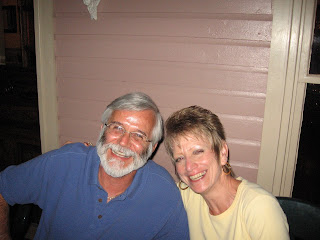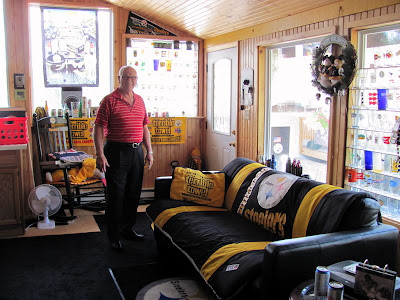 This 1788 house was the home of David Bradford, a leader of the 1794 Whiskey Rebellion. The rebellion was a protest by local farmers against a tax on whiskey that was easier to transport across the Allegheny Mountains to the markets on the East coast than the corn they grew. This was the first test of the power of the new government to collect taxes. The statue by local artist Alan Cottrill depicts the rebels who attacked federal officials in response to the tax. The house and statue are on South Main Street.
This 1788 house was the home of David Bradford, a leader of the 1794 Whiskey Rebellion. The rebellion was a protest by local farmers against a tax on whiskey that was easier to transport across the Allegheny Mountains to the markets on the East coast than the corn they grew. This was the first test of the power of the new government to collect taxes. The statue by local artist Alan Cottrill depicts the rebels who attacked federal officials in response to the tax. The house and statue are on South Main Street. Another important building is the 1812 home of Dr. John Lemoyne (right) whose son Francis was a famous abolitionist and the builder of the first crematory in the US (left). Since Washington was very close to Virginia before West Virginia was formed during the Civil War this home was an important stop on the Underground Railroad. The home is on Maiden Street, Route 40, and the crematory is at the top of the hill on South Main Street.
Another important building is the 1812 home of Dr. John Lemoyne (right) whose son Francis was a famous abolitionist and the builder of the first crematory in the US (left). Since Washington was very close to Virginia before West Virginia was formed during the Civil War this home was an important stop on the Underground Railroad. The home is on Maiden Street, Route 40, and the crematory is at the top of the hill on South Main Street. Three miles west of the city is the "S" Bridge that was part of the original National Road, today's Route 40. Also known as the Cumberland Road, it was the first federal highway project. Construction began in 1805 in Cumberland, Maryland and reached Wheeling, Virginia by 1818. The white sign posts with the mileage to local and distant towns are found all along the road. It never did make it to Jefferson City, Missouri as planned because money ran out by the time it reached Vandalia, Illinois. This structure is one of several original stone bridges you will see if you get off the Interstate and travel beautiful and historic Route 40.
Three miles west of the city is the "S" Bridge that was part of the original National Road, today's Route 40. Also known as the Cumberland Road, it was the first federal highway project. Construction began in 1805 in Cumberland, Maryland and reached Wheeling, Virginia by 1818. The white sign posts with the mileage to local and distant towns are found all along the road. It never did make it to Jefferson City, Missouri as planned because money ran out by the time it reached Vandalia, Illinois. This structure is one of several original stone bridges you will see if you get off the Interstate and travel beautiful and historic Route 40. This is Old Main, an 1834 building on the campus of Washington and Jefferson College. The school dates back to 1787 and is the oldest college west of the Allegheny Mountains.
This is Old Main, an 1834 building on the campus of Washington and Jefferson College. The school dates back to 1787 and is the oldest college west of the Allegheny Mountains. This is a statue of Perry Como who was a barber in nearby Canonsburg before he hit the big time. Canonsburg is also the home of Bobby Vinton and the Four Coins.
This is a statue of Perry Como who was a barber in nearby Canonsburg before he hit the big time. Canonsburg is also the home of Bobby Vinton and the Four Coins. Another interesting stop is the Breezy Heights Tavern in West Middletown. This restaurant is in a building that is right out of the 1930's Big Bands era. The dining room was the old dance floor and this menagerie of wild animals fills the stage. This is a great little place to eat and enjoy the ballroom that, except for the animals, is still decorated as it was in the 30's.
Another interesting stop is the Breezy Heights Tavern in West Middletown. This restaurant is in a building that is right out of the 1930's Big Bands era. The dining room was the old dance floor and this menagerie of wild animals fills the stage. This is a great little place to eat and enjoy the ballroom that, except for the animals, is still decorated as it was in the 30's. We had another great lunch with the retirees and helped the September birthday people celebrate. That is one happy crew (Tom, Sandy, John, Lena & Paul) waiting to cut into that cake. This group knows how to enjoy retirement as they get together once a week to share food and fun and never talk about school.
We had another great lunch with the retirees and helped the September birthday people celebrate. That is one happy crew (Tom, Sandy, John, Lena & Paul) waiting to cut into that cake. This group knows how to enjoy retirement as they get together once a week to share food and fun and never talk about school. On our last night in WashPA we went to the Back Porch in Speers to celebrate Tom's birthday. This is a great restaurant that is in one of the oldest buildings in Western Pennsylvania. If you go there ask for a table in the Side Door the little bistro in the basement.
On our last night in WashPA we went to the Back Porch in Speers to celebrate Tom's birthday. This is a great restaurant that is in one of the oldest buildings in Western Pennsylvania. If you go there ask for a table in the Side Door the little bistro in the basement.We have had a great time catching up with friends and family here, but as October approaches it is time to start heading south to warmer weather. We were planning to depart for Washington, DC this morning, but we decided to wait one more day to miss the heavy rain they are having east of the Allegheny Mountains. After DC we are going to spend a month on the Outer Banks in Avon, NC and then head to Florida for a couple of months.



















